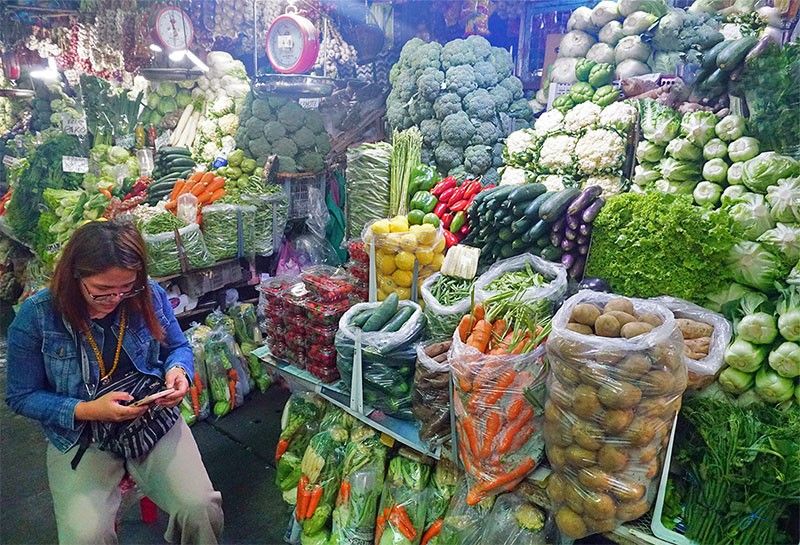Inflation up slightly, but still within target

April’s 3.8 percent print beats most forecasts
MANILA, Philippines — The rate of increase in the average prices of consumer goods and services typically purchased by Filipinos rose slightly to 3.8 percent in April from 3.7 percent in March, driven by faster increases in food and transport costs, according to the Philippine Statistics Authority (PSA).
This was the third straight month that inflation picked up, but the April inflation print was lower than the 6.6 percent in the same month last year and beat the forecast of over four percent made earlier by economists.
It was also within the 3.5 to 4.3 percent forecast of the Bangko Sentral ng Pilipinas (BSP).
In a press briefing, National Statistician Dennis Mapa noted that the food and non-alcoholic beverages group was the primary driver of the higher overall inflation in April. Inflation for the heavily weighted commodity group posted a faster uptick of six percent in April from the previous month’s 5.6 percent.
Inflation for food alone rose to 6.3 percent in April from 5.7 percent in March due mainly to the faster increase in vegetables, tubers, plantains, cooking bananas and pulses at 4.3 percent in April from 2.5 percent in the previous month.
Rice inflation eased, but remained elevated at 23.9 percent in April from 24.4 percent in March.
Mapa said the lower rice inflation might be due to the declines in world market prices in February and March after these peaked in January.
He also said two of the three varieties of rice in the country being tracked by the PSA – well-milled and special rice – registered slight declines.
The average price of well-milled rice went down to P56.42 per kilo in April from the previous month’s P56.44 per kilo, while the average price of special rice decreased to P64.68 per kilo in April from P64.75 per kilo in March.
The average price of regular milled rice, meanwhile, increased to P51.25 per kilo in April from P51.11 in March.
“It would depend on local production and supply from the world market if it (rice inflation) would continuously go down,” Mapa said.
Also driving the higher inflation was the transport commodity group, which posted a faster uptick of 2.6 percent in April from 2.1 percent in March.
Core inflation, which excludes certain food and energy items, slowed to 3.2 percent in April from the previous month’s 3.4 percent.
Despite April inflation remaining within the government’s target range, National Economic and Development Authority Secretary Arsenio Balisacan emphasized the need to be vigilant.
“We are taking comprehensive measures to ensure food security amid geopolitical concerns and weather patterns worsened by climate change,” Balisacan said.
According to Balisacan, the government’s strategies are aimed at boosting productivity, building the agriculture sector’s resilience and making food systems efficient.
He also highlighted the need to augment local production during shortages to ensure affordable and sufficient food supply.

“Food insecurity extends beyond economic strain – it directly impacts the well-being of all Filipinos. Failing to augment local production during shortages perpetuates poverty and exacerbates vulnerability,” Balisacan said.
Headline inflation averaged 3.4 percent from January to April, well within the BSP’s two to four percent target range.
The central bank remains optimistic that average inflation for 2024 and 2025 will stay within the target band despite upside risks.
The BSP sees headline inflation breaching the target range temporarily in the next two quarters due to the negative impact of weather conditions on agricultural output as well as positive base effects.
“Nonetheless, the BSP expects average inflation to return to the target range for full year 2024 and 2025,” the central bank said.
Based on its assessment at its policy review on April 8, the BSP sees full-year inflation at 3.8 percent this year before easing further to 3.2 percent in 2025. Both forecasts are significantly below the six percent average in 2023.
However, if risks materialize, the BSP expects inflation to hit four percent in 2024 and 3.5 percent in 2025.
The BSP said risks to the inflation outlook continue to lean toward the upside.
“Possible further price pressures are linked mainly to higher transport charges, elevated food prices, higher electricity rates, and global oil prices. Potential minimum wage adjustments could also give rise to second-round effects,” it said.
The Monetary Board will also consider the April inflation data and the first-quarter gross domestic product (GDP) output, along with other information, during its next policy review on May 16.
After hiking policy rates by 450 basis points from May 2022 to October 2023, the BSP has kept the benchmark interest rate at a 17-year high of 6.50 percent to tame inflation, anchor inflation expectations and stabilize the peso.
Despite high interest rates, economic growth prospects remain intact for 2024 and 2025, the central bank also said.
“GDP growth is projected to remain robust in the first half, decelerate in the second half due to positive real interest rates following the BSP’s tightening cycle, and subsequently pick up in 2025,” the BSP said.
“This outlook is consistent with the expected shift to a slightly negative output gap in 2024 to 2025, suggesting that the growth momentum of the economy remains firm and that a hard landing appears to be unlikely,” it added.
The Philippine economy grew by 5.5 percent in 2023, falling short of the government’s six to seven percent target. The PSA will release first-quarter GDP data on May 9.
Oikonomia Advisory & Research Inc. president and chief economist John Paolo Rivera said inflation may continue to pick up “due to the full effects of El Niño on agricultural production, prompting supply constraints on food products.”
For his part, Oxford Economics economist Makoto Tsuchiya said inflation is expected to edge higher in May, largely due to base effects.
“Even with subdued sequential price momentum, the annual inflation rate will hover around four percent in the coming few months, before declining towards the end of the year,” he said, noting upside risks remain, particularly on commodity prices including fuel and rice, with high uncertainty around the supply-side.
- Latest
- Trending





























